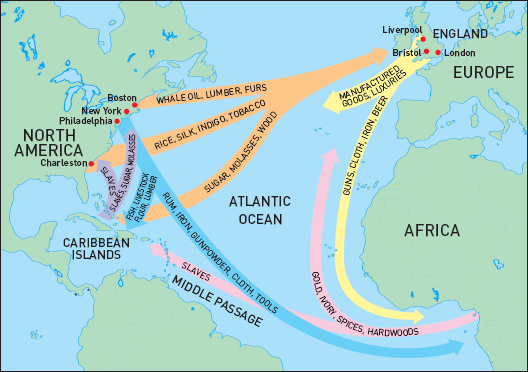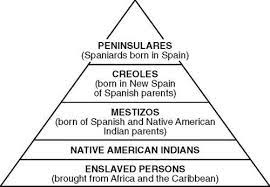1.5 Labor, Slavery, and Caste in the Spanish Colonial System
4 min read•june 18, 2024
Caleb Lagerwey
Robby May
AP US History 🇺🇸
454 resourcesSee Units
The Slave Trade
As disease and years of fighting diminished the Native American populations in North and South America, Europeans began looking for a new labor force. Africans were brought to the new world, first to South America and then eventually to North America. An estimated 12 million African Americans were forcibly brought to North and South America during the slave trade (1500s-1800s).
The transatlantic slave trade was the system of buying, selling, and transporting African people to the Americas and other parts of the world as slaves. It was a major part of the Atlantic trade network, known as the triangular trade, which also included the trade of goods such as sugar, tobacco, tea, rifles, and other products. The transatlantic slave trade was a significant part of the history of the Americas, and it had a profound and lasting impact on the societies and economies of the region.

The Triangular Trade; Image Courtesy of the Smithsonian Learning Lab
Conditions aboard slave ships were horrendous. Slaves were kept chained in the steerage, and it is estimated that millions of African Americans died during the voyage. The most brutal part of the voyage came to be known as the Middle Passage (the voyage across the Atlantic Ocean). Here is a first-hand description of the conditions inside the slave ships:
“The closeness of the place, and the heat of the climate, added to the number in the ship, which was so crowded that each had scarcely room to turn himself, almost suffocating us. This produced copious perspirations, so that the air soon became unfit for respiration, from a variety of loathsome smells, and brought on a sickness among the slaves, of which many died, thus falling victims to the improvident avarice, as I may call it, of their purchasers. This wretched situation was again aggravated by the galling of the chains, now become insupportable; and the filth of the necessary tubs [large buckets for human waste], into which the children often fell, and were almost suffocated. The shrieks of the women, and the groans of the dying, rendered the whole scene of horror almost inconceivable.”
Source: The Interesting Narrative of the Life of Olaudah Equiano, published in 1789
The first Africans arrived as indentured servants in the colony of Virginia in 1619. Quickly thereafter, the indentured servitude system was abandoned, and all Africans came as slaves. European traders partnered with West African groups who practiced slavery in order to forcibly extract laborers to the Americas. Slaves completed hard labor for mining and plantation agriculture.
Under chattel slavery, slaves were considered the property of their owners and had no legal rights. They could be bought, sold, traded, or inherited, just like any other form of property. Slaves were often subjected to cruel and inhumane treatment, including physical abuse, sexual abuse, and separation from their families. They were forced to work long hours in dangerous and grueling conditions without pay or any form of compensation.
Spanish Labor Systems
The Spanish conquistadors, a group interested in God, glory, and gold under Hernan Cortes, quickly implemented the encomienda system in New Spain. In this system, the king of Spain gave grants of land and natives to individual Spaniards, known as encomenderos, in exchange for their loyalty to Spain. The Native Americas, termed encomendados, had to farm or work in the mines extracting precious metals and resources. Their fruits went to their Spanish masters, who in turn, had to “care” for them.
Ultimately, the encomienda system was introduced by the Spanish Crown as a way to establish a labor force in the colonies and convert Indigenous people to Catholicism. In practice, the encomienda system exploited and abused indigenous peoples for free labor. As European diseases demolished the Native Americans, the Spanish turned to importing Africans under the asiento system. This system required the Spanish to pay a tax to their kind on each slave they imported to the Americas.

The diversity of European, African, and Native American groups led the Spanish to develop a caste system to define the status of these populations under the Spanish empire based on race and ethnicity. This social hierarchy determined the social, economic, and political status of individuals in the colonies.
Under the Spanish caste system, ancestry divided people into distinct categories. At the top of the hierarchy were the Spanish elites, who were of pure European ancestry. Below them were the mestizos of mixed European and Indigenous ancestry. At the bottom of the hierarchy were the Indigenous people and the African slaves, considered the lowest class.
The Spanish caste system was deeply discriminatory and oppressive, implemented to justify the exploitation and abuse of Indigenous people and African slaves. It was also a significant factor in the development of racial and ethnic divides in the Spanish colonies, which continue to have a lasting impact on the societies of Latin America today.
Browse Study Guides By Unit
🌽Unit 1 – Interactions North America, 1491-1607
🦃Unit 2 – Colonial Society, 1607-1754
🔫Unit 3 – Conflict & American Independence, 1754-1800
🐎Unit 4 – American Expansion, 1800-1848
💣Unit 5 – Civil War & Reconstruction, 1848-1877
🚂Unit 6 – Industrialization & the Gilded Age, 1865-1898
🌎Unit 7 – Conflict in the Early 20th Century, 1890-1945
🥶Unit 8 – The Postwar Period & Cold War, 1945-1980
📲Unit 9 – Entering Into the 21st Century, 1980-Present
📚Study Tools
🤔Exam Skills
👉🏼Subject Guides
📚AMSCO Notes

Fiveable
Resources
© 2025 Fiveable Inc. All rights reserved.